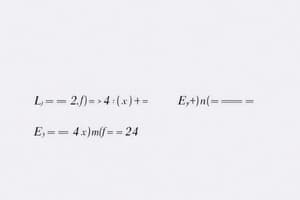Podcast
Questions and Answers
Which of the following best describes the primary economic motives behind imperialism?
Which of the following best describes the primary economic motives behind imperialism?
- Securing new markets and accessing raw materials. (correct)
- Establishing cultural exchange programs with colonized regions.
- Providing humanitarian aid to impoverished populations.
- Promoting democratic governments in developing nations.
How did the Industrial Revolution contribute to the rise of imperialism?
How did the Industrial Revolution contribute to the rise of imperialism?
- It promoted isolationist policies among European nations.
- It decreased the demand for raw materials and new markets.
- It reduced the economic disparities between nations.
- It created a need for new markets and resources. (correct)
What was the concept of 'Armed Peace' referring to in the lead-up to World War I?
What was the concept of 'Armed Peace' referring to in the lead-up to World War I?
- A build-up of military forces and heightened tensions despite the absence of open conflict. (correct)
- A period of disarmament among major European powers.
- A series of peaceful negotiations mediated by international organizations.
- An economic union aimed at preventing future wars.
Which aspect of imperialism led to disparate economic outcomes between European powers and their colonies?
Which aspect of imperialism led to disparate economic outcomes between European powers and their colonies?
How did ideological justifications play a role in the expansion of imperialism?
How did ideological justifications play a role in the expansion of imperialism?
Which of these was a consequence of imperialism for the occupied peoples?
Which of these was a consequence of imperialism for the occupied peoples?
Which of the following territories would NOT typically be considered as administered under imperial powers?
Which of the following territories would NOT typically be considered as administered under imperial powers?
What was a primary source of economic rivalry between France and Great Britain that contributed to the tensions leading up to World War I?
What was a primary source of economic rivalry between France and Great Britain that contributed to the tensions leading up to World War I?
Which type of territory describes an area where a foreign power controls trade and investment but does not directly govern?
Which type of territory describes an area where a foreign power controls trade and investment but does not directly govern?
What term refers to the policy of extending a nation's power and influence through diplomacy or military force?
What term refers to the policy of extending a nation's power and influence through diplomacy or military force?
How did nationalism contribute to the rise of tensions before World War I?
How did nationalism contribute to the rise of tensions before World War I?
What was the role of technological advancements during the era of imperialism?
What was the role of technological advancements during the era of imperialism?
In what way did colonial administrations impact local economies in occupied territories?
In what way did colonial administrations impact local economies in occupied territories?
Which long-term effect did the redrawing of colonial boundaries have on post-colonial nations?
Which long-term effect did the redrawing of colonial boundaries have on post-colonial nations?
How did the concept of social Darwinism influence imperialist ideology?
How did the concept of social Darwinism influence imperialist ideology?
Which of the following was a common feature of colonial rule in Africa and Asia?
Which of the following was a common feature of colonial rule in Africa and Asia?
What was the impact of colonial education systems on local populations?
What was the impact of colonial education systems on local populations?
How did the Berlin Conference (1884-1885) impact Africa?
How did the Berlin Conference (1884-1885) impact Africa?
In what way did resistance movements in colonized territories influence the decline of imperialism?
In what way did resistance movements in colonized territories influence the decline of imperialism?
How did the legacy of colonialism affect international relations in the post-World War II era?
How did the legacy of colonialism affect international relations in the post-World War II era?
Flashcards
Imperialism
Imperialism
A policy of extending a country's power and influence through colonization, use of military force, or other means.
Industrial Revolution & Imperialism
Industrial Revolution & Imperialism
The need to expand markets and obtain new raw materials.
Justification of Imperialism
Justification of Imperialism
The ideological justification of imperialism and nationalism.
Economic Objective of Imperialism
Economic Objective of Imperialism
Signup and view all the flashcards
Economic Consequences of Imperialism
Economic Consequences of Imperialism
Signup and view all the flashcards
Social & Cultural Consequences of Imperialism
Social & Cultural Consequences of Imperialism
Signup and view all the flashcards
Administration of Occupied Territories
Administration of Occupied Territories
Signup and view all the flashcards
WWI Antecedents
WWI Antecedents
Signup and view all the flashcards
Study Notes
Introduction to Partial Differential Equations (PDEs)
- A PDE involves an unknown function with two or more variables and its partial derivatives.
- The general form of a PDE is represented as F(x, y, u, ux, uy, uxx, uyy, uxy,...) = 0, where x and y are independent variables, u = u(x, y) is the dependent variable, and ux, uy, uxx, uyy, uxy are partial derivatives.
- The order of a PDE is determined by the highest order derivative in the equation.
- First-order PDE example: ∂u/∂x + ∂u/∂y = u
- Second-order PDE example: ∂²u/∂x² + ∂²u/∂y² = 0
- PDEs can be classified as linear if the dependent variable and its derivatives appear linearly, otherwise, they are nonlinear.
- Linear PDE: A(x, y)ux + B(x, y)uy + C(x, y)u = f(x, y)
- Nonlinear PDE: uxuy + u = 0
Examples of PDEs
- Wave Equation: ∂²u/∂t² = c² ∂²u/∂x²
- Heat Equation: ∂u/∂t = α ∂²u/∂x²
- Laplace Equation: ∂²u/∂x² + ∂²u/∂y² = 0
- Poisson Equation: ∂²u/∂x² + ∂²u/∂y² = f(x, y)
Classification of Second-Order Linear PDEs
- The general form of a second-order linear PDE in two independent variables is A(x, y)uxx + B(x, y)uxy + C(x, y)uyy + D(x, y)ux + E(x, y)uy + F(x, y)u = G(x, y).
- The discriminant Δ = B² - 4AC is used to classify the PDE.
PDE Classification based on the Discriminant
- Hyperbolic: Δ > 0
- Parabolic: Δ = 0
- Elliptic: Δ < 0
PDE Type Examples
- Wave Equation: utt = c² uxx is Hyperbolic because Δ = 4c² > 0.
- Heat Equation: ut = α uxx is Parabolic because Δ = 0.
- Laplace Equation: uxx + uyy = 0 is Elliptic because Δ = -4 < 0.
Boundary Conditions Types
- Dirichlet Boundary Condition: Specifies the value of the solution on the boundary as u(x, y) = f(x, y).
- Neumann Boundary Condition: Specifies the normal derivative of the solution on the boundary as ∂u/∂n = g(x, y), where n is the normal direction.
- Robin Boundary Condition: A combination of Dirichlet and Neumann conditions, given by αu + β(∂u/∂n) = h(x, y) on the boundary.
Boundary Conditions Example
- For the heat equation ut = α uxx on the interval [0, L]:
- u(0, t) = T1 represents a Dirichlet boundary condition.
- (∂u/∂x)(L, t) = 0 represents a Neumann boundary condition, indicating an insulated boundary.
Solution Techniques for PDEs
- Separation of Variables: Assumes the solution can be written as a product of functions, each depending on one independent variable, such as u(x, t) = X(x)T(t).
- This method involves substituting the product into the PDE and separating the variables to obtain ordinary differential equations (ODEs).
Heat Equation Solution Example via Separation of Variables
- For the heat equation ut = α uxx with boundary conditions u(0, t) = 0 and u(L, t) = 0:
- Assume a solution: u(x, t) = X(x)T(t).
- Substitute into the heat equation: X(x)T'(t) = α X''(x)T(t).
- Separate variables to get: (T'(t))/(αT(t)) = (X''(x))/(X(x)) = -λ, where λ is a separation constant.
- Solve the ODEs: T'(t) + α λ T(t) = 0, giving T(t) = A e^(-αλt), and X''(x) + λ X(x) = 0.
- Apply boundary conditions to find X(x).
Other Solution Methods
- Fourier Transforms: Useful for problems on infinite domains.
- Laplace Transforms: Useful for problems with time-dependent boundary conditions.
- Numerical Methods: Includes finite difference, finite element, and spectral methods, used for complex problems without analytical solutions.
Studying That Suits You
Use AI to generate personalized quizzes and flashcards to suit your learning preferences.




